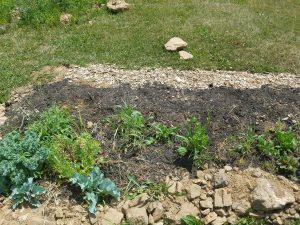What is a Swale?
A swale is a combination trench and planted mound dug and built along the contours of the land. Swales can be used to create new garden beds or be retrofitted to existing garden beds to boost their functionality and productivity.
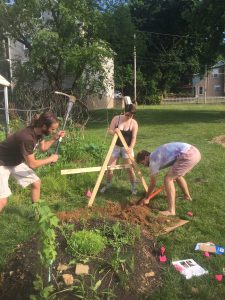
Why Should We Build Swales?
Swales allow the gardens to harvest all the rainwater that would otherwise run over top grass or around garden beds, letting the water penetrate deep into the soil to nourish the roots of the plants grown in the berm of the swale. This reduces the need for us to go out into the garden with a watering can, giving us more time to chill, while also reducing the impact on aging storm water and sewer systems.
Swales not only harvest water that runs across the landscape, but filter it as well through the mycelial network of fungal species living in the wood chips of the trench. These fungi exude enzymes that can break down polluting compounds that leach into the water (from cars, asphalt shingles, or your neighbor who uses roundup’s yard) and turn them into sugars.
Plants love the moist conditions and excellent drainage that comes along with a swale, and you are sure to love the abundant food, medicine, and materials that they will create with minimal maintenance required!
How to Build a Swale
The first step of building a swale is to find contour. A contour line (or curve) is a path along the landscape that is a equal altitude at every point. Sometimes contours are straight or one smooth curve, but many times they are wavy and can even make abrupt turns as different slopes intersect. Finding contour is extremely important, because a swale off contour will direct water away rather than sinking it into the ground (this can sometimes be desirable, for example if one area is very we and another is very dry). To find contour, you will need to build an A-frame level and find contour.
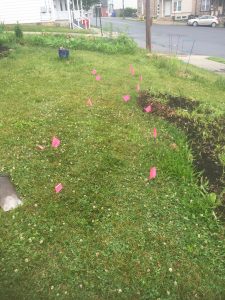
Now that you have the contours mapped, you can plan where you want to actually put the swales, the paths and walkways, benches, herb spirals, and other features of the garden. The wood chip filled trench of the swale makes great path, with easy access to the plants growing in the swale. It is important to start with the contours before deciding where to put these other features, because the contours determine where water flows. Also be conscious of other determining features like large trees and buildings that cast shade on the garden.
Once we know where we want the swales, we mark three lines of contour at least eight inches apart, and dig out the section between to upper two lines. It is important to keep the front and back edges of the trench on contour and the bottom level to harvest maximum rain water. Flip the sod from the trench just down slope to smother grass under what will become the bed. Cardboard can also be used to smother the grass.
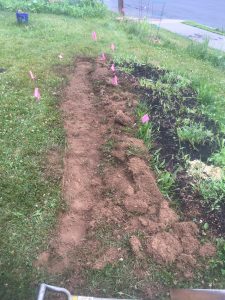
Be sure to periodically check that the trench is maintaining contour while you are digging.
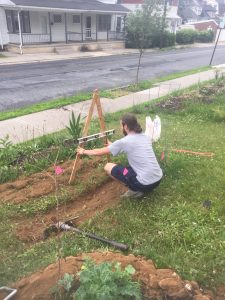
Once the trench is at least eight inches deep, it can be filled with wood chips and inoculated with fungi like stropharia or trametes (if desired).
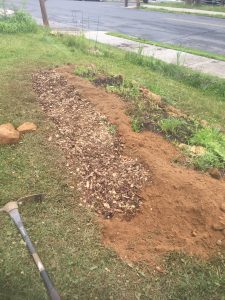
Throw some compost and topsoil on the mound, plant into it, and mulch it up another two inches (at least) with wood chips (if starting plants from seed, wait until plants start to grow and then mulch around seedlings with wood chips as they grow). Boom- we’ve got a swale!
